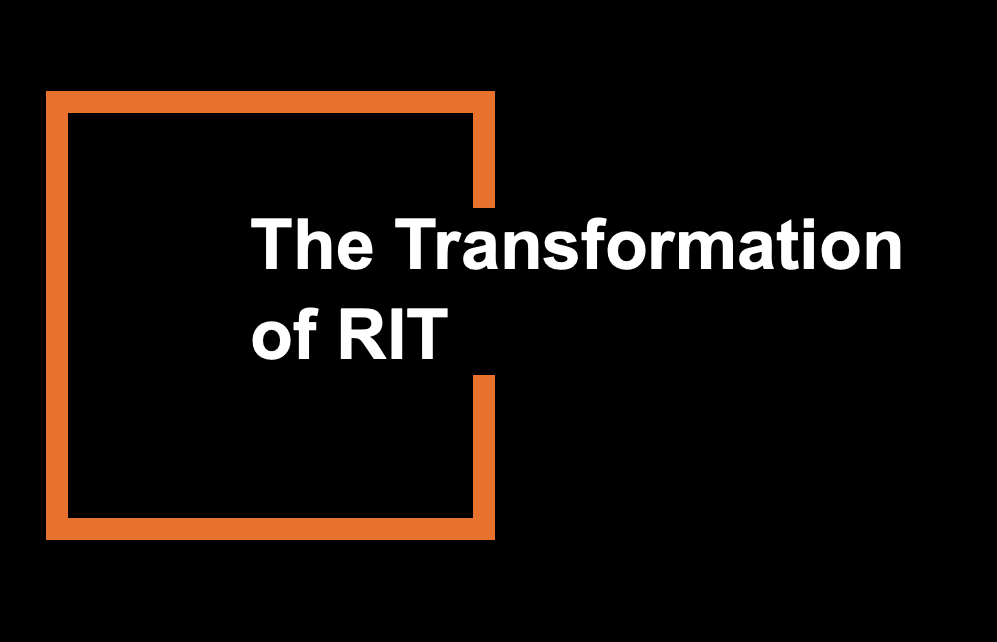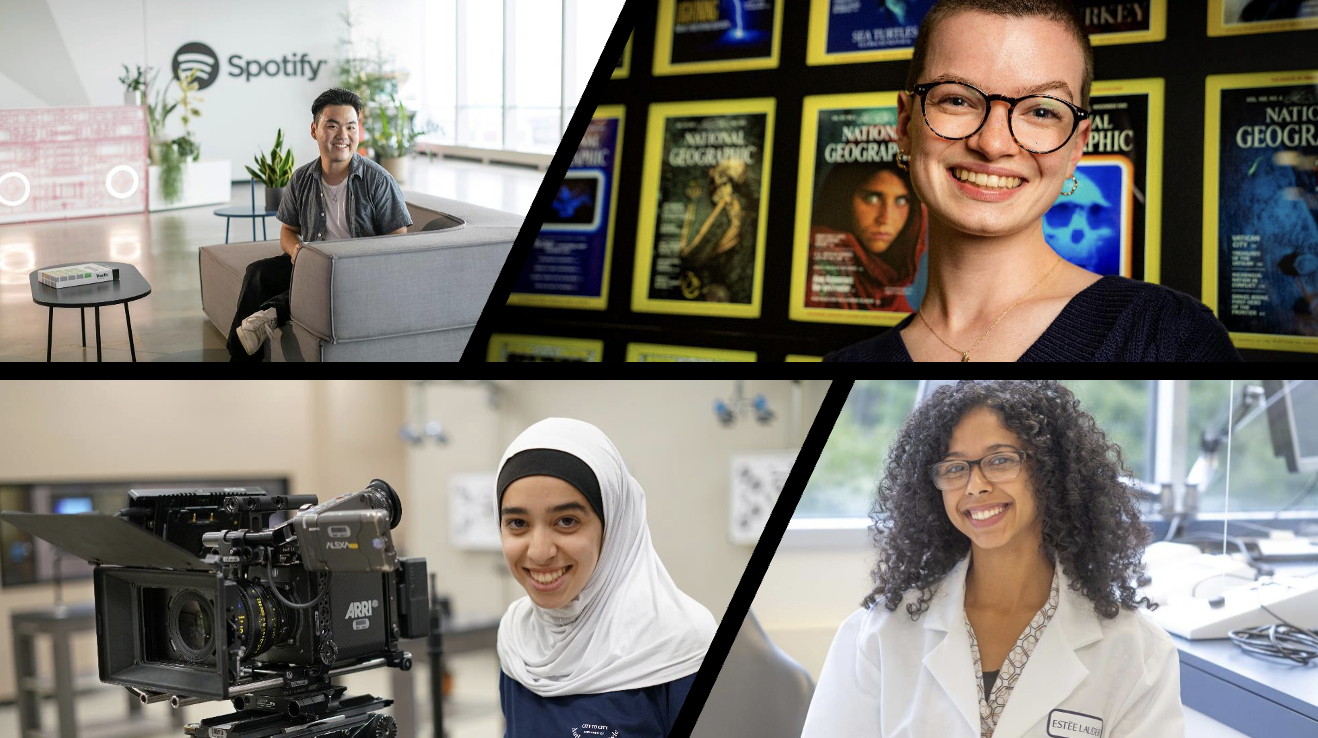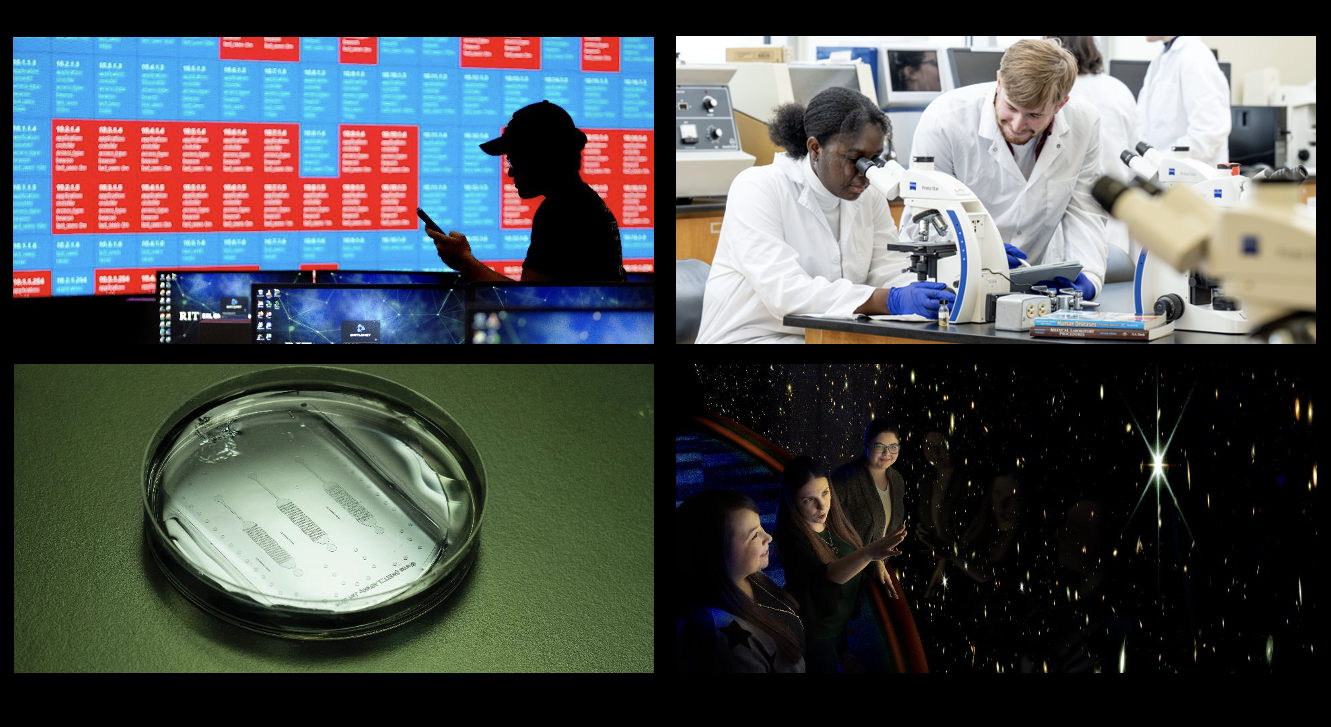The Transformation of RIT
Note: On April 18, 2024, RIT President David Munson addressed members of the Genesee Valley Club in downtown Rochester as part of the Distinguished Speakers Series. Munson’s address was titled “The Transformation of RIT.”
Good evening. Thank you for inviting me to be a part of the speaker series at the Genesee Valley Club. It is an honor and privilege for me to be with you tonight.
Tonight, I plan to review some of our most recent university accomplishments. And then I will lay out some of the challenges, opportunities, and vision we have for RIT’s bright future. My objective is to leave you with an impression that accurately reflects the RIT of today as well as our aspirations in the future.
Let me sum up this address with a headline: RIT is perpetually creating the future and taking a leading role on the global stage!
OK, OK … I know. I need to back this statement up.
But before I do all that, we need some historical context for how RIT elevated to where it is today — one of the top universities in the nation working at the intersection of technology, the arts, and design. You will recognize these RIT and Rochester leaders.
Let’s start with President Al Simone, who joined RIT in 1992. At that time, RIT had just one Ph.D. program — Imaging Science, the first of its kind in the nation. Under Al’s leadership, we added doctoral programs in microsystems engineering, computing and information sciences, and color science. We formed the Golisano College of Computing and Information Sciences, now our largest college. We also opened our first global campus in Dubrovnik, Croatia. And Al approved the move to Division I men’s hockey.
Then, President Bill Destler took the reins from Al and extended the path with a focus on creativity and innovation. In 2008, we opened a campus in Dubai, and we held our first Imagine RIT: Creativity and Innovation Festival, now a tradition and showcase for the ingenuity of our students and faculty. Under Bill, we also built the Golisano Institute of Sustainability, MAGIC Center, and the Gene Polisenni Center, after we also moved women’s hockey to Division I.
I am sure people were cautious and nervous when many of these decisions were being contemplated. Do we need these things? How will we pay for them? But what would RIT be today without these Ph.D. programs? Our global campuses? Our world-class facilities? Presidents Simone and Destler took calculated risks, and we must continue doing the same.
Today, we are building on the foundation laid by these two gentlemen and their predecessors.
Many of you in this room have graduated from prestigious universities. Let me be clear: We have no ambition to imitate any other institution. For us, it’s all about creativity and innovation in every discipline, and in removing the barriers between disciplines. We're recruiting students that perhaps would not have chosen to attend RIT in the past. It’s because of things we offer outside the classroom. I’ve pushed hard on the notion of experiential learning, which includes co-op, but also includes a lot of other things. We want our students to have an international experience. We want our students to have a start-up company. We want our students to be on a project team. And we want our students, in general, to become citizens of the world.
RIT enrollment at our Henrietta campus is now at an all-time high of 16,500 students. We didn’t let the global pandemic slow our momentum, and today we remain in high demand with a record number of undergraduate applications for our incoming fall class of 2024. We are seeing a higher-quality pool of applicants, based on standard measures such as GPAs, rank in class, and leadership traits. Our current first-year class is the most well-rounded and academically prepared ever at RIT. Their average high school GPA was a record 93, and 60 students graduated first in their class. RIT now enrolls more than 400 Ph.D. students in 12 Ph.D. programs with two more programs coming in the fall.
We are truly a global university with nearly 2,000 international students from 103 countries on the Henrietta campus. At our global campuses in China, Croatia, Dubai, and Kosovo, our enrollments continue to increase as we add new programs. This past fall, we are at a record high of more than 3,600 at our international locations.
Behind these numbers are amazing students with diverse interests who come together to grow and thrive. They are thriving by getting involved in 300+ clubs and student organizations. They are thriving by interacting with cultures different from their own. They are thriving by competing against the best from across the globe and bringing home top prizes at national and international collegiate competitions. They are thriving by landing co-ops, internships, and other forms of experiential learning to find and develop their passions. And they are thriving by becoming successful alumni with rewarding careers and fulfilling lives outside of work.
RIT
The outside world knows who we are now. We are going up against a more competitive league of universities. This means:
- Dethroning Stanford in a cybersecurity competition.
- Outperforming the likes of the University of Michigan and Purdue in a global Baja vehicle competition.
- Beating Notre Dame in hockey during our Brick City Homecoming weekend
- Winning the Atlantic Hockey Championship and advancing to the NCAA tournament with the remaining top 16 teams.
Let’s talk about our elevation in another arena. Greatness is bringing goodness to the world through research and discovery. We had yet another record year in sponsored research awards, attaining $94 million. Some key areas of investigation include nanotechnology, optics and imaging science, cybersecurity and artificial intelligence, and growth in life sciences and health fields. Many of these awards were funded by national agencies such as NSF ($16.5 million), the Department of Defense ($14.5 million), and the NIH ($8.1 million) as well as large awards from NASA and the Department of Energy. We also received $14 million in research awards from the state of New York.
Yes, RIT is appropriately taking its place on the international stage.
A few examples:
- We are one of six U.S. universities named as part of an international USA-Japan partnership that was announced at the G7 Summit in Japan. This effort is being led by Micron Corp., which has already committed to invest $100 billion over the next 20 years to construct a new megafab facility outside Syracuse. The objective is to focus on improving competitiveness in computer chip design, development, and manufacturing here in the United States. You will be hearing a lot more about chip manufacturing in the Greater Rochester region this year and beyond.
- Governors Island, a historic site in New York Harbor will be the home to a new world-leading climate solutions center that will position New York City as a global leader in addressing one of the most pressing issues of our time. RIT is part of “The New York Climate Exchange,” a first-of-its-kind consortium, bringing public and private higher education institutions and global companies like IBM and Moody’s together. The goal is huge: Develop and deploy effective solutions to our global climate crisis. Sponsored by the New York City Mayor’s Office and the Trust for Governors Island, The Exchange was awarded to a consortium selected through a highly competitive process. RIT is a proud higher education partner, joining other prestigious institutions including Stony Brook University, Duke, Georgia Tech, Oxford, and the University of Washington.
- Our ESL Global Cybersecurity Institute was selected by Google to manage a Cybersecurity Clinic Fund and train new cybersecurity professionals. On the other side of the globe, RIT Dubai announced a partnership with MasterCard to foster talent and advance Artificial Intelligence innovation globally.
- NASA wants more resilient spacecraft to survive longer and harsher missions in the future. So, who did they turn to in their quest for new discoveries in remote parts of the solar system? RIT’s Center for Detectors!
Opportunities abound for this university. Let me briefly outline where we see RIT’s role in the future of health care:
Consider:
- Healthcare is the single largest employer sector in the United States and accounts for about 20 percent of the nation’s GDP.
- Our aging population utilizes healthcare services three times more than younger generations.
There are enormous workforce shortages in healthcare professions including nursing, physical therapy, occupational therapy, and other areas. These are major opportunities for growth in the College of Health Sciences and Technology.
So, looking ahead, our College of Health Sciences and Technology is developing doctoral programs in Physical Therapy and Occupational Therapy. We also are planning a Nursing BSN program as we scope out our strategy. These efforts are leveraging our partnerships with Rochester Regional Health. As healthcare demands surge, RIT can be an active player in contributing to the healthcare system locally, nationally, and globally. There is much work to do, but the opportunities in this arena are huge for RIT.
RIT is accustomed to audacious goals. Together, the RIT community brainstormed, conceptualized, designed, problem solved, collaborated, and constructed a new place where creativity and innovation can come to life. We engineered the largest project in our history, and this fall the doors opened to the SHED (Student Hall for Exploration and Development). We are transforming RIT by building places and spaces for thinkers, creators, and makers unlike any other university in the nation. Big ideas can turn into reality. And that message is energizing our student body.
From morning classes into evening extracurriculars, the SHED is the new heartbeat of the campus. I am confident that incredible things will be produced and invented in the SHED. And I’m sure some of those things will form the basis for student start-up companies.
RIT is more than about taking five courses each semester and working as hard as you can to get As. The SHED is allowing our students to think laterally, to be creative, and to apply what they've learned in the classroom to innovate and solve real problems.
RIT is a university where engineers and scientists can pursue the performing arts, techies can tackle the humanities, and artists learn to code. To that end, more than 500 new students received a Performing Arts Scholarship this fall, bringing the number of Performing Arts Scholars to more than 1,800 students.
We also recently began construction on a 750-seat Music Performance Theater designed to support musical theater productions at RIT. I envision that the entire RIT community will have an opportunity to engage with this “making” facility, be it as an actor, singer, dancer; or building sets, programming displays; designing costumes; or working on sound, lighting, or stage crew. This venue is expected to open in 2025.
Other construction projects you will see around campus include:
- Max Lowenthal Hall: The expansion project for our Saunders College of Business was just finished. This doubles the building’s footprint and offers cutting-edge teaching and learning spaces, opportunities for innovative research, and state-of-the-art event and collaboration spaces.
- Research Building: We are expanding our research footprint to accommodate the university’s growing research portfolio. Construction of a modern research facility has been underway since last summer. The facility will provide more laboratory space in science, computing, and engineering. Occupancy is expected later this fall.
- Tiger Stadium: Beginning in spring of 2024, we will begin construction of a stadium complex featuring new seating, locker rooms, concessions, and a press box.
We also are designing our future as we are charting what this campus will look like in the next 25 to 50 years with a new Campus Plan. This is a long-term planning document that provides a conceptual layout to guide future growth and development on our 1,300 acres. Themes of the Campus Plan include densification of the central core of the campus, creation of a new Half Mile that will parallel our Quarter Mile, moving the loop road to the north, conversion of parking lots to parking decks, and making better use of our natural environment. The plan also identifies sites for future buildings, whether they be residence halls, research facilities, or classroom buildings.
We would be remiss if we did not acknowledge that we face challenges and strong headwinds. War, climate change, natural disasters, social unrest, a dysfunctional government, high interest rates—it is stressful keeping up with the flow of global news these days. We can be consumed by the dark headlines.
Or we can flip the narrative by eagerly working on solutions. The world needs collaborative thinkers who can identify and solve the most pressing and vexing problems of our times. Embracing challenges brings out the best in RIT. Let’s take just one example — Artificial Intelligence.
AI is an engine of innovation that is driving scientific discover and economic growth. AI is one of the most significant advances of our time. RIT is well-positioned to play an integral role in teaching and innovation in AI in a multitude of forms. Right now, hundreds of RIT researchers are developing a range of applications using AI, varying from education to medical monitoring devices to deepfake detection tools. Along with our core strength in technology and experiential learning, we have complementary strengths in the arts and design, making RIT a unique environment to study, build, and test AI. We must also pursue our work with an understanding of ethical and socio-technical lenses.
To synergize our activities, we have created an AI task force that will help shape our work in the areas of research, scholarship and innovation, teaching and curriculum, and experiential AI on campus. Breakthroughs in AI will change the way we teach our classes and will alter most of our curriculum. Researchers will employ AI techniques in a multitude of application areas, making major leaps in discovery and innovation. And yet the most intriguing effects of AI at RIT may be on community life and in our business operations. We already have staff members using AI in their daily work. This is just the tip of the iceberg. You can imagine AI buddies and smart, mobile robots transforming campus life over the next 10 to 20 years.
We are starting to see this future emerge in industrial and healthcare settings, so I think we're in a great position to anticipate what is to come. Overall, we aspire to be an AI university, working within an ethical framework to invent a more prosperous, sustainable, and equitable future.
Indeed, RIT is perpetually creating the future. And we are writing the next chapters. But don’t just take my word for it. Witness it yourself on Saturday, April 27 at Imagine RIT, our creativity and innovation festival. This is our signature event that will showcase 350 exhibits the ingenuity of our students, faculty, and staff across the campus. Imagine RIT has opportunities for everyone of all ages.
This your invitation to join us April 27th. Make it your day of discovery. Let’s inspire the next generation of problem solvers by connecting young people to the wonders of creativity and innovation.
Thank you again for this opportunity to speak tonight. At RIT, we pride ourselves in inspiring imaginations and experiencing the future. And we hope we inspire you and the Rochester community. Thank you.
RIT











